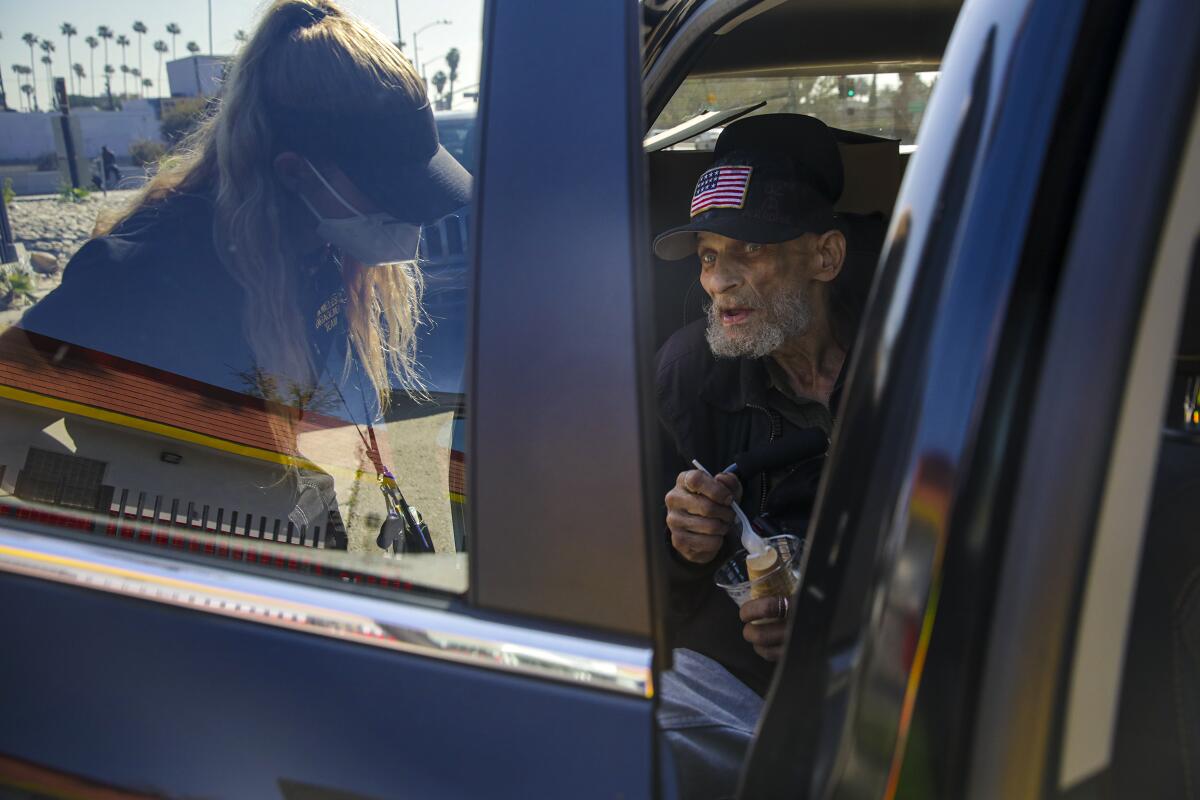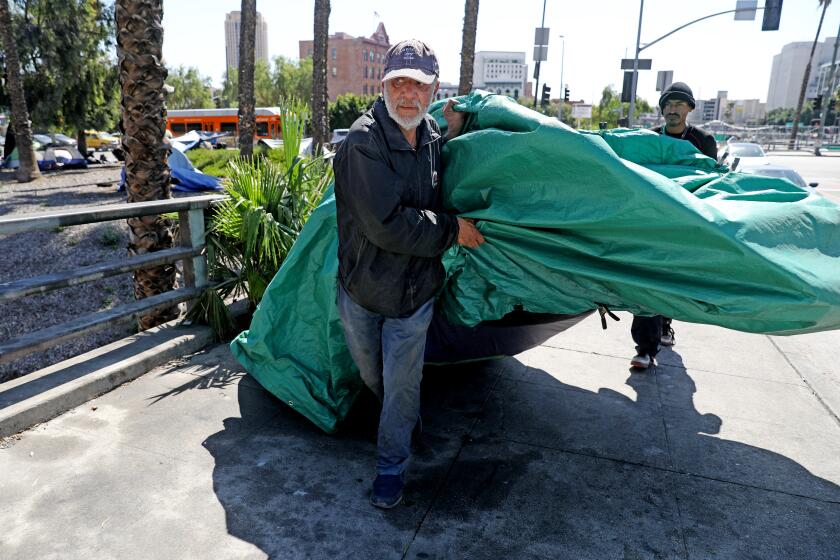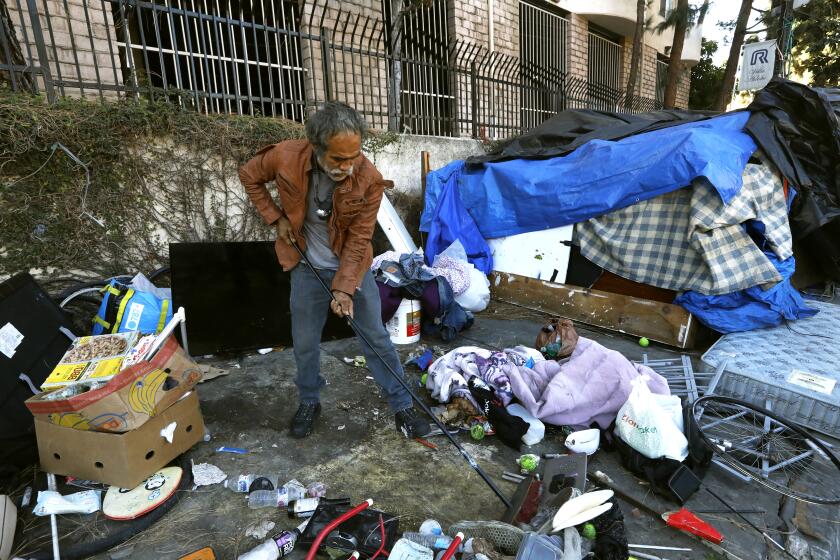Many homeless people resist group shelters even as L.A. mayoral candidates push to build more

- Share via
The Los Angeles mayoral primary has seen candidates throwing big numbers around concerning how much shelter they’d like to see built for homeless people.
Rick Caruso wants 30,000 new beds in his first year in office, Rep. Karen Bass says 15,000 new beds in hers and Councilman Joe Buscaino wants 9,000 new beds within 36 months, to name a few of the candidates’ publicized ideas.
The candidates haven’t broken down exactly how many of those beds would be group shelters, but to achieve those lofty goals there probably would need to be a large number of them.
The question is, if these beds are built, will homeless people use them?
New research from the Rand Corp. suggests that the type of shelters that could end up being the centerpiece of multiple candidates’ homeless plans is not homeless people’s preferred destination. Fewer than a third of those surveyed in Hollywood, skid row and Venice said “group shelter” was an acceptable housing option.
“There seems to be very low appetite among people to move into group shelters, which seems to be a key part of the landscape of a lot of mayoral proposals,” said the study’s lead writer, Jason Ward, the associate director of the Rand Center for Housing and Homelessness in Los Angeles.
Ward noted that the city is already depending heavily on group shelters to entice people off the streets as it begins enforcing its revised camping ban, known by its municipal code, 41.18.
Some candidates — including Councilman Kevin de León and Bass — have expressed discomfort with the group shelter model in which dozens of people sleep close together in bunk beds. During the pandemic, these locations became the sites of superspreader events even as their capacities were reduced greatly — sometimes by 50% or 75%.
Others, like City Atty. Mike Feuer, acknowledge that the scale of the need means the city can’t totally discount congregate settings. At a recent forum on homelessness, he pointed to the shelters the city has built through its A Bridge Home program as a more dignified alternative because each person has a smaller cubicle that isn’t completely walled off but does have some privacy. These locations also were the sites of large outbreaks of COVID-19.
Enforcement of Los Angeles’ revised anti-camping law rolls out in slow and uneven steps.
The survey results resonated for Wendell Blassingame, who sat at his usual card table Tuesday with an umbrella for shade in San Julian Park. Blassingame hands out masks and water and seeks out ways to help skid row’s sickest and most vulnerable. He’s 74 and formerly homeless and has lived in a single-room occupancy unit in the neighborhood for many years.
“You want your peace and dignity,” he said. “In a dorm setting, you can’t get that.”
Blassingame’s unit is small, but at least he has a key and the knowledge he can lock the door and close his eyes each night.
Los Angeles has undertaken a major shift in its approach to homelessness, one that puts a priority on clearing unsightly street encampments.
He said he hears from the people he helps about the challenges they face in large shelters, where dozens of people sleep in bunks together — theft, lack of privacy and curfews. If you get there after 7 p.m., in some cases, you’re not allowed inside, he said.
Most people on skid row want housing but they also want some space to call their own, he said.
“Our society doesn’t cater to the seniors who are homeless here and might have a disability,” he added. “It’s depressing. It brings tears to my eyes.”
The Rand survey joins a growing body of local research striving to expand on the picture of homelessness drawn by the annual count conducted by the Los Angeles Homeless Services Authority.
The research institute’s survey was a microscopic version of the annual count in which thousands of volunteers search street by street over vast stretches of Los Angeles County for signs of homelessness. Small teams of Rand researchers zeroed in on three communities with known concentrations of homeless people.
The survey asked questions to probe one of the central unknowns in the debate over how to help the most people on the street: the extent to which they are open to or resistant to offers of housing.
Over the last two years, the city has built thousands of new tiny homes, which are private but lack a bathroom, rented thousands of hotel rooms and bought more than a thousand apartment and hotel units. All of this added capacity has been used in high-profile efforts to clear public spaces such as parks, sidewalks and locales like the Venice boardwalk or the area around El Pueblo de Los Angeles Historical Monument.
The Rand researchers found that nearly 90% of unsheltered people they interviewed indicated “interest” in receiving housing but that the response varied widely depending on the type of housing.
About 80% said they would accept a private room in a shelter or hotel, a “permanent” stay in a motel or hotel-like setting or permanent supportive housing. About 60% would accept interim housing with access to services, while about 50% of people surveyed said shared housing or safe camping would work. Only 30% would accept recovery or sober living housing.
Get the lowdown on L.A. politics
Sign up for our L.A. City Hall newsletter to get weekly insights, scoops and analysis.
You may occasionally receive promotional content from the Los Angeles Times.
Some of the responses also pointed to shortcomings in the services delivered to people on the street and the inadequate number of people who do that work.
Nearly half of respondents said they have been offered housing since they became homeless and a third said they were currently on a waitlist. More than 40% said the reason they weren’t in housing is that no one followed up with them after the initial offer of housing.
Ward said he thought that could be related to cleanups that force people to frequently move their tents and possessions. “But also it may be related to issues with caseworker overload and turnover and other factors like that, that just break the links between individuals in need of housing and outreach,” he said.
Asked for reasons they would reject an offer of housing, 38% of respondents said privacy was their biggest concern, far outweighing resistance to housing rules (19%), not being able to have a partner (14%) or pets (10%) or possessions (10%).
Louis Abramson, an astrophysicist who has done the statistics for volunteer homeless counts in Echo Park, Mid-City and Eagle Rock/Highland Park, said the Rand survey has provided valuable new insights with questions on housing preference that are not included in the annual count.
“That’s a part of the conversation that’s been missing,” said Abramson, who is now running for state Assembly. “The fact that these authors have the measure of that is very important.”
The researchers returned several times over four months starting in October to build a more dynamic picture than the annual “point-in-time” count.
Over the course of the survey, they observed increases in all three neighborhoods, averaging 17%.
Benjamin Henwood, a USC researcher who is doing a study tracking individuals over time, found that while it is unlikely the increase is a long-range trend, it may indicate seasonal variations that aren’t captured by the annual count.
“This is a good effort, doing a place-based survey and seeing whether and how things change over time,” said Henwood, a faculty researcher with the university’s Suzanne Dworak-Peck School of Social Work.
Ward said he hopes to extend the Rand study to provide a better understanding of seasonal change and continue offering a deeper, more nuanced picture of the needs of people who live on the street.
More to Read
Sign up for Essential California
The most important California stories and recommendations in your inbox every morning.
You may occasionally receive promotional content from the Los Angeles Times.









